-
THE KILLING OF TWO LOVERS (Robert Machoian 2020)
ROBERT MACHOIAN: THE KILLING OF TWO LOVERS (2020)
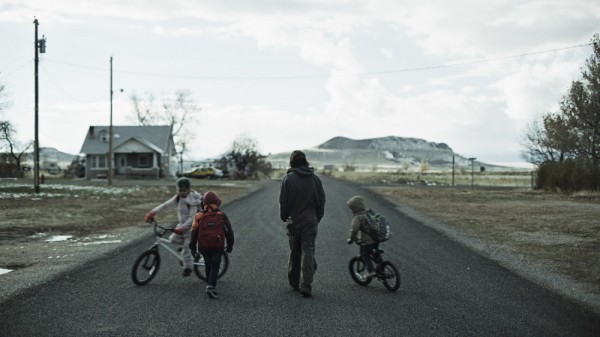
Repressed violence
Repressed violence is the underlying theme of this interesting new film from Robert Machoian, which focuses on a couple in a trial separation. Some of his opportunities he has missed. There is a long dialogue between husband and estranged wife in a truck that's bold, and most of the scenes with kids are remarkably specific and natural. The hammering sound throughout (the obtrusive "soundscape" of Peter Albrechtsen), more suitable to a horror film, continues at the end to undermine the seemingly happy ending. Is worse violence afoot? Subtlety is one thing, confusion is another. And I'm not sure I quite believe the premise. But I have to admit the twist and its positive outcome worked for me.
David (Clayne Crawford) seems like a doormat, but he seethes inside, moved in with his dad nearby leaving his wife Nike (Sepideh Moafi) in the house with the four kids, three bouncy young ones who plainly adore him, and the teenage (but isn't the actress too old-looking?) daughter who is miserable with what's going on and wants it to stop. His wife seems to want this, a separation that's "open," so either person can be with somebody else. There's no indication David wants it. Why does he agree to it? This film is all in the dialogue, which pops with energy and realism, but doesn't quite define a conceivable situation.
A "compact, economical portrait," yes; a nice grayish yet colorful palette in the mostly Academy ratio images. Rural Utah landscapes that don't look at all clichéd. "An interior drama set mostly outside."
ND/NF blurb:
After a startling opening image of extreme tension, first-time solo director Robert Machoian’s stark, slow-burn drama never quite goes where you expect. An evocative and atmospheric transmission from wintry Utah, The Killing of Two Lovers is a compact, economical portrait of a husband and father trying to keep it together while seething with rage during a trial separation from his wife. An interior drama set mostly outside, on the vast, lonely street where David (a knockout Clayne Crawford) stays with his ailing father just a few doors up from his wife Niki (Sepideh Moafi) and their four kids, Machoian’s film compassionately depicts a family in crisis, while moving at the ominous pace of a thriller. A complex, brooding soundscape from Peter Albrechtsen that seems to emanate directly from the head of its disturbed protagonist, and a claustrophobic aspect ratio contribute to the powerful emotional register of this impressive new work of American independent cinema.
The Killing of Two Lovers, 84 mins., debuted at Sundance Jan. 2020; three other US festivals including New Direcdtors/New Films Mar. 2020, where it was screened for this review. US theatrical release slated for Sept. 2020. Currently screening in the delayed virtual pandemic edition of ND/NF in Dec. 2020.
Last edited by Chris Knipp; 12-14-2020 at 09:23 AM.
-
BABYTEETH (Shannon Murphy 2019)
SHANNON MURPHY: BABYTEETH (2019)
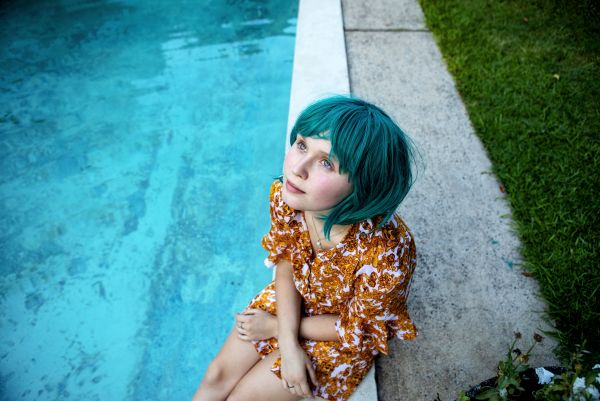
ELIZA SCANLON IN BABYTEETH
Cancer requires new rules for parenting
This is a fresh and original Australian feature. It's just a bit hard to know how to take it. Is it serious? Or is it all a lark? And if it's a lark, is not taking a teenager with fatal cancer lightly not shockingly frivolous?
Milla (Eliza Scanlen of Little Women) is the teenager in question, and she's sixteen. Her meet-cute with Moses (Toby Wallace) happens at a train station where she has a nose bleed and collapses. Moses immediately takes charge, with an intimacy and charm (and closeups by a camera that loves him) that belies his battered-looking face because its lines are good. Wallace has the manner of a homeless kid, but an older one - he answers to 23 - and one that's blooming with health and sexiness. He's of an age when drugs and shifty living haven't caught up with him yet. We later learn he's kind of a bourgeois hoodlum. He immediately establishes a voluptuous intimacy with Milla, with a sense that he's got problems too (like drugs, using and dealing). He's got a mother, who breeds fancy dogs and has a younger son, and a nice house. She inexplicably hates Moses and keeps chasing him away (his backstory is never clear), but he keeps going back there. His father he admits he knows little of, and hasn't gotten on well with. Yet there is a gentleness about him and love of life, a sweet smile, and an eagerness to care for Milla though she isn't sure he loves her.
About Milla there seems little to learn, not even about her disease, which is never specified, and there is only one hospital scene, though she gets chemo and spends more than half the film shaven-headed, with multiple wigs - an opportunity for giddy playacting and charming Moses. We learn more about her parents. Her mother Anna (Essie Davis) is highly-strung and chronically self-centered and a gifted pianist, who has a connection with the quirky, offhandedly passionate man with a heavy accent who teaches Milla violin (Eugene Gilfedder), also to a little Asian boy he insists is in love with Milla. Her father Henry (the great Ben Mendelsohn) is a psychiatrist, and works out of a wing of their bright, airy modern house. Anna and Henry have a mock appointment, a regular thing, the inter-title tells us, where (we find out, to our embarrassment) he very casually screws her. He is listening, later, to a patient who is having a major breakthrough (she says) which he abruptly interrupts to go and screw in a lightbulb for the very pregnant neighbor he encounters regularly, a kind of running joke. He is in running midlife crisis but he's pretty sexy too.
The whole movie seems a running joke signaled by the oddball running titles of segments that may be deemed necessary to order the episodic structure, or cutesy, or borderline twee.
Again, the question: is it a good idea to run a funny undercurrent to a film about cancer? Well yes, maybe it is. We need humor to help us get through the heartache. And this film is at least half about youth, that's beautiful even in disaster and resilient enough to make light of the heaviest things, to get through them.
Henry and Anna are a running melodrama. Moses is a disaster that can laugh itself off and turn it into sweetness. Milla is a tragedy that can be fragile and angry but also steely.
Milla invites Moses to her school's formal dance, and prepares for it with a dress her mother brings her that matches her current wild blue wig, but in the event it doesn't matter. All that matters are the moments. Anna has strong objections to bringing Moses into the house, but she and Henry can deny her daughter nothing because she may have no time. "This is the worst possible parenting I can imagine," she declares to Henry, wisely, as they see Moses climbing on top of Milla out on the lawn. Her first love is possibly her only love and he's not the nice boy with a promising future but he's what they'e got even if he's fleecing his underage girlfriend for money and drugs.
Babyteeth earns the unfortunate classification "dramedy," but it avoids sentimentality despite having a trajectory that links it with the weepie. Its quirks are at least its own. This is Shannon Murphy's third feature, adapted from her own play by Rita Kalnejais. She is talented and original and is slated to direct the third season of the much-discussed BBC series "Killing Eve."
Babyteeth, 11Babyteeth, 117 mins., debuted at Venice Sept. 2019, showing at a dozen other international festivals, including New Directors/New Films, where it was screened for this review (except the press screenings were stopped midway and the series was cancelled, due to the coronavirus pandemic). An IFC Films release in the US with a planned release date of June 19 - in theaters (originally) and available on demand. (It can now be rented on Amazon Prime - 6/29/2020.)
Last edited by Chris Knipp; 06-28-2020 at 08:43 PM.
-
DWELLING IN THE FUCHUN MOUNTAINS 富春山居圖 ( Gu Xiaogang 2029)
GU XIAOGANG: DWELLING IN THE FUCHUN MOUNTAINS (2019)
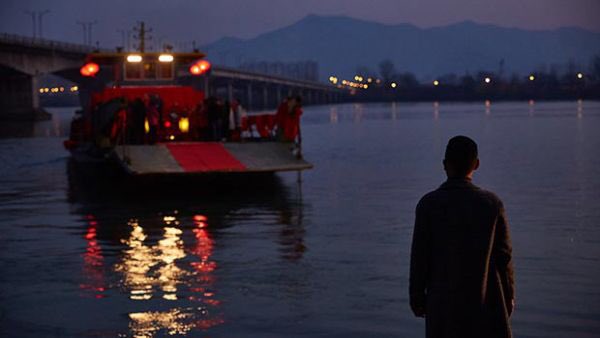
[Watched; not reviewed]
Dwelling in the Fuchun Mountains
Gu Xiaogang, China, 2019, 150m
Fuyang dialect and Mandarin with English subtitles
New York Premiere
Taking its title from a renowned 14th Chinese scroll painting by Huang Gongwang, this debut feature from Gu Xiaogang is a panoramic evocation of one year in the life of a provincial family. In tribute to its artistic inspiration, the film often presents its action from a quiet distance, the camera lyrically moving across the frame as its central characters—the members of the sprawling Yu family, overseen by an aging matriarch (Du Hongjun), whose birthday celebration opens the film—deal with business and romantic entanglements, financial debts and work struggles. All the while the seasons inexorably change. Dwelling in the Fuchun Mountains was shot over the course of two years, and is the first in a declared trilogy of films about life along the Yangtze River—a first-time filmmaker’s labor of love that’s as accomplished as it is ambitious.
Dwelling in the Fuchun Mountains 富春山居圖, 150 mins., debuted at Zurich; nine other international festivals, including Zurich, Hamburg, Vancouver, Busan, ,Tokyo, Rotterdam, Gothenberg and New Directors/New Films; it is not included in the delayed virtual Dec. 2020 version of ND/NF, however.
Last edited by Chris Knipp; 12-15-2020 at 01:23 AM.
-
SERVANTS (Ivan Ostrochovský 2020)
IVAN OSTROCHOVSKY: SERVANTS (2020
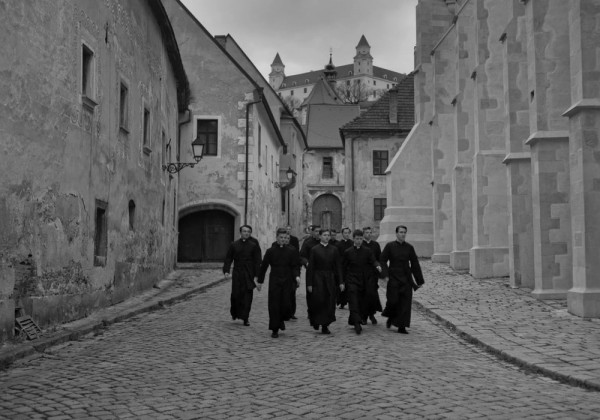
Aesthetics triumphs over story in this tale of Soviet era religious repression
Slovak filmmaker Ivan Ostrochovský's movie shows the aesthetics of totalitarianism. The focus is a seminary in 1980 during the period (1971 to 1989) when "Pacem in terris" was a decree and a body that existed in Czechoslovakia, created to repress Catholicism, and some of the priests and their acolytes rebelled, resulting in brutal repression.
It's all shown in academy ratio and black and white in the velvety cinematography of Jural Chlpik accompanied by a menacing, throbbing score. Every scene is beautifully composed. Cold stone and snow add to the contrast. The novitiates, some handsome, trim in their long black soutanes, enhance the graceful uniformity of the images, and a scene of a mountain town has medieval charm.
One could just sit and admire the sound and pictures, but this is about modern history. What's going on is ugly, and, indeed, comes on wearing the air of a noir thriller. "Where're not here to enjoy ourselves," says a priest to a boy at one point, and that's putting it mildly. If you find it hard to see being Catholic as being free, the action may confuse you. These young men, seeking a life of the cloth, find its expression stifled. One must imagine, if one's in a very special place to cultivate one's religion, and one is hampered at every turn, because the regime sees one's Church as a threat, the oppression is outside the house.
There's a priest beaten and murdered and dumped out of a trunk under a bridge. There is a hunger strike. A couple of the novitiates are eliminated. Much is going on here. But it's conveyed collectively, like a dance. We don't get to see all the young men in any detail. Even courtyards are often seen from above, like a mouse cage. Most of the action is seen from the point of view of two newly arrived novitiates, Michal (Samuel Polakovic) and Juraj (Samuel Skyva), who see things are not as they should be and grow growingly tense and outraged. As the noirish strain grows, there is a growing fear by some priests that there is too much independence here among the boys, and the seminary will be shut down. They are being put under pressure to act as informants on any nonconformist behavior, or be removed and sent into the army. It's all like a deadly, nightmarish dance. One can admire Ostrochovský's artistry, while feeling the cold beauty somewhat blurs the story details. Handsome film, though.
Servants / Služobníci, 80 mins., debuted at Berlin, Feb. 2020 and was included in a dozen or so international festivals, winning a number of nominations and awards.
Last edited by Chris Knipp; 05-10-2021 at 09:28 AM.
-
ANNE AT 13,000 FEET (Kazik Radwanski 2019)
KAZIK RADWANSKI: ANNE AT 13,000 FEET (2019)
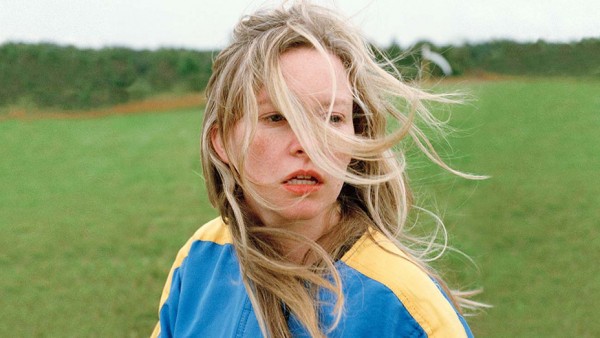
DERAGH CAMPBELL IN ANNE AT 13,000 FEET
Portrait of a woman in dysfunction
Anne (Deragh Campbell) is seen almost nauseatingly up close in this minimalist, leanly edited, music-free portrait of a dysfunctional young woman trying to set out on her own. We see her twice, start and finish, sky-dive from a small plane, and it's not a more out-of-control moment than usual. In fact, while falling through the air is one time when Anne isn't likely to do something unpredictable and disruptive. She moves out from her mother to her own place, takes a part0time daycare center job and starts dating a guy, but does this mean she's got things under control or is out on her own? Not really. Radwanski, his star, and his editor are doing top work here. There's only the little nagging question: is it worth it?
Deragh Campbell has been seen in a number of ND/NF films, including last year's oddball MS Slavic 7, and Radwanski produced another portrait of a lost adult child, Tower,, seen in ND/NF 2013 (I rated it "sub mumblecore") The current effort, which takes us through Anne's moments of charm and strong empathy with children at the daycare and her childlike clumsiness with fellow workers and social contacts, has been compared to John Cassavetes working with wife Gena Rowlands in A Woman Under the Influence, but maybe those who're making that comparison need to go back and look at the original. This film feels more like a reality show. There is a lack of depth or humanity here.
Anne at 13,000 Feat, 75 mins., debuted at Toronto Sept 2019, and was shown at a half dozen other festivals in 2020 including Vancouver, AFI, Portland, and now, ND/NF which was postponed from Mar. to Dec. 2020 due to the paneemic.
Last edited by Chris Knipp; 12-15-2020 at 10:29 AM.
-
TWO OF US / DEUX (Filippo Meneghetti, 2019)
FILIPPO MENEGHETTI: TWO OF US/DEUX (2019)
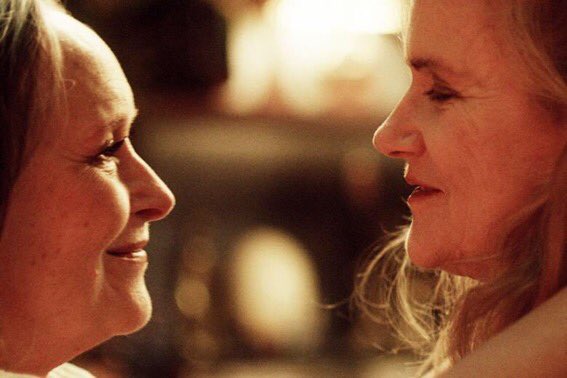
MARTINE CHEVALLIER, BARBARA SUKOWA IN TWO OF US/DEUS
Secret lesbian romance leads to complications in Italian Filippo Meneghetti's directorial debut, in French and set somewhere in the south of France and shot near Montpellier.
Former tour guide Nina Dorn (the handsome Barbara Sukowa, a protegee of Fassbinder), who lives in a facing apartment on the top floor of the building, has long been the lover of Madeleine (Martine Chevallier of the Comédie-Francaise), but secretly; no one, even Maddie's adult divorced daughter Anne (Léa Drucker), knows about this relationship, though how very loving and happy it is we are shown very clearly in scenes of sweetness and smiles. The couple is well into retirement age, but only now they are planning to sell Madeleine's very nice apartment and go to live together at last, in Rome where they met so many years ago. An Italian version of a corny but romantic pop song is their reminder of that moment; they dance to it still.
The plan is for Maddie to tell Anne about the relationship and the plan. Not surprisingly, after all these years of secrecy, in the event, at the end of a birthday dinner for her, she chokes. She just doesn't seem to be ready to do it. When Nina finds out this change of heart from the real estate agent, it's beyond disappointing and into infuriating. Nina speaks harshly with the more conventional Maddie in the street in front of the estate agent.
The result of this spat is dramatic indeed. Shortly thereafter, Maddie has a stroke. The bulk of the movie is what happens after that.
The film has had a good reception in France. It is slated for US release by Magnolia in Feb. 2021. It's in a good position, but its status as a bold work by a new director fits it, marginally, for the New Directors series, though it seems like firm arthouse material. I sympathize with the writer for the French publication Les Inrockuptibles who said it took two great actresses to crack the code of the sometimes clumsy and maladroit direction. There are many early hints, for instance, of a distance between the two women that are not appropriate; the camera is often either too close or too far away. Expressionism wasn't needed!
Meneghetti stirs up a good deal of melodrama, where it might do better to have drawn up a screenplay that showed how such very human problems might be safely resolved. After a while, we're just in a movie. The action seems to me rather implausible, and at once too eventful and too slow. But the look of the film is handsome, and the ladies are, needless to say, magnificent. Numerous viewers (Letterboxd, for instance) have expressed gratitude for a movie about older lesbians, and asked for more. In that this is welcome. Women who identify with Maddie and Nina will appreciate this film, even though its story details may not have that much to do with them.
Two of Us/Deux, 95 mins., debuted at Toronto and showed in at least 15 other international festivals, including ND/NF, as part of the virtual form of which it was reviewed for this film. AlloCiné press rating 3/6/5.
Last edited by Chris Knipp; 05-10-2021 at 09:32 AM.
-
RED MOON TIDE/LÚA VERMELHA (Lois Patiño 2020)
LOIS PATIÑO: RED MOON TIDE/LÚA VERMELhA (2020)
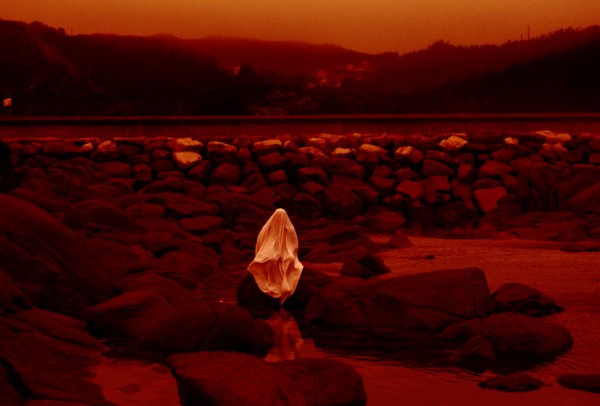
STILL FROM LUA VERMELA
Gorgeous images of a haunted world staged along the Galician coast of Spain
The young Spanish filmmaker Lois Patiño has a penchant for haunted, beautiful landscapes and for the human history embedded in his own native landscape. In this film the focus is on a fishing village along the Galician coast, rock tides, and death in the water. Village people, engaged for the film enterprise, lend their stubby bodies and stolid gazes to Patiño, who uses them arrestingly as statues or mannequins posed near the water, in a small grove, in an awesome, empty building, or in a quiet, old fashioned family house interior.
A simple narrative theme runs through the images. Rubio (Rubio de Camelle) is a fisherman who is also diver who has specialized for years in retrieving drowned bodies from shipwrecks, who himself has disappeared, and villagers speculate about whether he will reappear. He believed a monster is hunting the shores of his coastal town as he discovered corpses around as he takes his boat out in the morning. Now his boat has run aground, without Rubio. Gradually statue-like figures appear around in landscapes and architectural interiors, tall, thin, immobile, draped in shimmering white. There is talk of phantoms and ghosts and demons and three witches coming for people. Themes of death and the water come and go.
It's impossible to exaggerate how subtle and beautiful these images are, the soft yellow-filtered tints, the reds, the textures of cloth: everything is like a sculpture or something made out of sewn cloth. And the colors, toward the end, when red begins to prevail, you can lose yourself in them. It is indeed a gorgeous picture of a phantom world, dreamland, nightmare, or perverse paradise? The scenes unfold, one after another exquisitely composed tableaux that transform what might in some cases be only ordinary images of everyday Spanish village life into mythical wonders. And the moons! The 37-year-old Patiño has mastered the art of turning images of everyday lives into the mythical.
This is filmmaking that is largely a celebration of the visual. The dreams or nightmares of a lost fisherman and a world of lost souls, a project long in gestation are nonetheless somewhat underdeveloped as narrative. But if you're willing to sit back and enjoy the eye candy, there's something rather unique here. The transition from his short films to this feature length has been a little uneven. This may be a pretty long slog for some people.
In an interview with Film Comment, the filmmaker has said that this long-gestating film was at first meant to be more of a documentary. But, I'd say, he is just too much of an artist and a dreamer to be contented with the real. Toward the end of the process of making Red Moon Tide, he says he "got very deep into H.P. Lovecraft," so he "eventually tried" to "bring the story a little towards the terror genre." Everything he loves and knows, he put into it. It's thus a film to study more than simply go and watch.
Red Moon Tied/Lua vermelha, 84 mins., debuted at the Berlinale Feb. 2020, also showing at Malaga, IndieLIsboa and Toulouse. Screened for this review as part of the delayed FLC New Directors/New Films 2020, online Dec. 2020.
Last edited by Chris Knipp; 12-19-2020 at 01:49 AM.
 Posting Permissions
Posting Permissions
- You may not post new threads
- You may not post replies
- You may not post attachments
- You may not edit your posts
-
Forum Rules





 Reply With Quote
Reply With Quote






Bookmarks